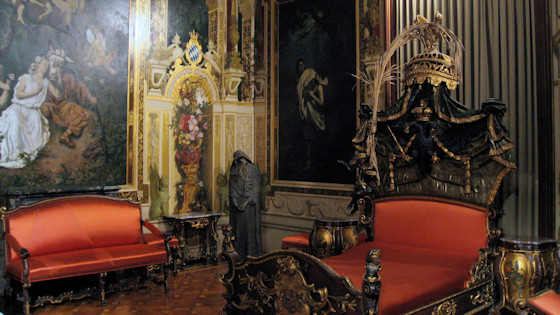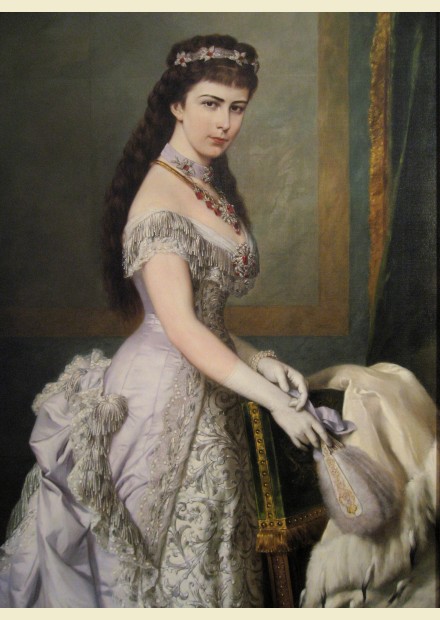The Hermesvilla is situated on the south-western outskirts of Vienna in the Lainzer Tiergarten, a former imperial hunting area. Emperor Franz Joseph donated the villa to his wife Empress Elisabeth, the legendary Sisi, as a "castle of dreams" in the hope that he would be able to keep his wife, who loved to travel, in Vienna more often. From 1882 to 1886, the famous Ringstrasse architect Carl von Hasenauer created this building.

In May 1887 the imperial family spent the first night in this magnificent villa. This house is full of references to Sisi's preferences: in front of the villa a statue of the messenger of the gods Hermes, from which the villa got its name, on the balcony a bust of Heinrich Heine, and in the stairwell a statue of the dying Achill, her favourite Greek hero.
At that time, the Hermes Villa was very modern, with electricity and water pipes. The architect Hasenauer once watched the empress open the taps again and again with obvious pleasure - and turn them on, because she didn't know anything like that yet.
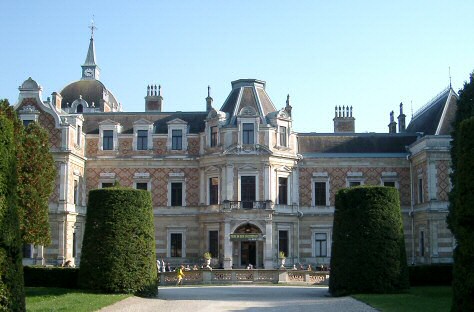
The Hermes Villa is a two-storey building with a façade cladding of big stone blocks and ribbon-like red and glazed bricks. It is a mixture of Renaissance and Baroque elements.

On the west facing front there is a covered driveway. The large stable and farm buildings, as well as the dwelling houses of the servants form with The castle has an elongated courtyard with a fountain by Viktor Tilgner showing Genoveva with the deer cow. The fountain already gives an insight into the romantic thinking of the Sisi, which was influenced by the 19th century.
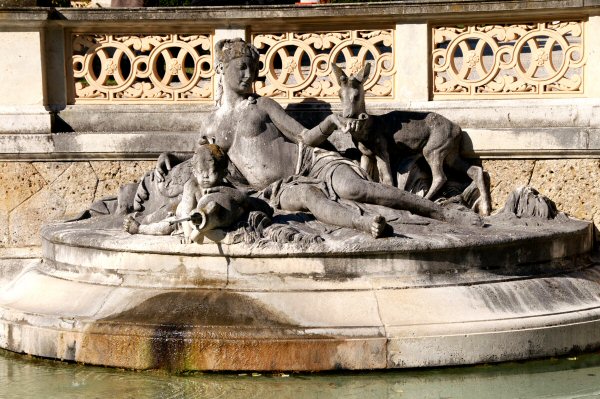
The legend tells of Genoveva of Brabant. in the eighth century. She was falsely accused of adultery and was sentenced to the sentenced to death. The executioner, however, released them. Then she lived with her newborn son in a cave for six years. There she was taken by the Mother of God Mary by means of a hind. Finally she found her husband Siegfried, who had always believed in her innocence. To thank for Genoveva's salvation he erected the pilgrimage church of Fraukirch (Rhineland-Palatinate)
In the 19th century various works with the theme Genoveva were created, for example the theater piece Genoveva by Friedrich Hebbel, which Robert Schumann used as the basis for his opera of the same name. (was performed in Feb 2008 at the Zurich Opera; conductor N. Harnoncourt). Gustav Schwab recorded the material in his German Volksbücher .
Genoveva
Opera in four acts by Robert Schumann (1810-1856)
Libretto by Robert Reinick and Robert Schumann,
after the tragedy «life and death of the holy Genoveva» by Johann Ludwig
Tieck and the tragedy «Genoveva» by Christian Friedrich Hebbel
First performance: 25 June 1850, Stadttheater, Leipzig
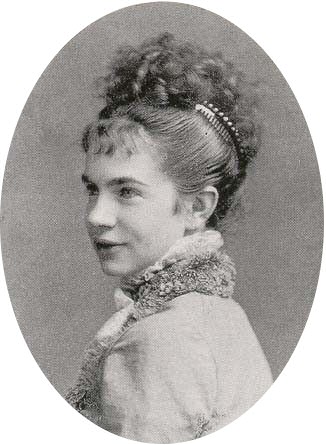
Visit to the Hermes Villa
After entering the chateau, you enter the octagonal vestibule with its heavy oak panelling in the Renaissance style. To the right of the vestibule was originally the residence of Archduchess Marie Valerie. In the large central room of the parterre, the Marble Hall, the whole family met for the common meal. Where the Café-Restaurant is located today, there were the rooms of Marie Valerie's sister, Archduchess Gisela.
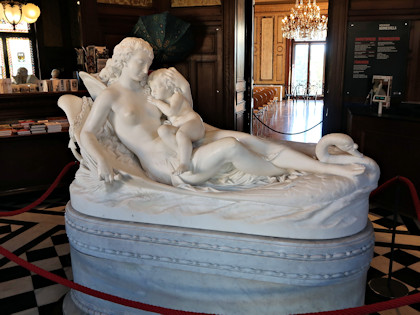
In the middle of the vestibule is the lying statue of the light fairy Peri. It was originally in Corfu and was made by Charles Francis Fuller.
The fairy from Persian mythology has long curls and butterfly wings, whereby the butterfly stands for the volatility of life. She holds a sleeping child in her arms and glides on a swan over the water floods.

Behind it is the entrance to a banqueting hall on the ground floor.

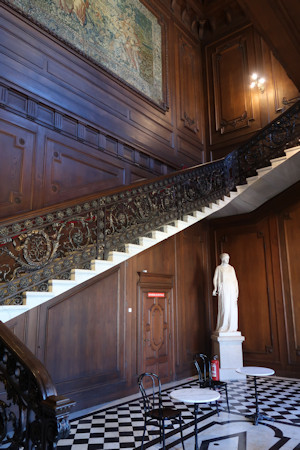
A magnificent staircase leads up to the first floor, where the private chambers of Emperor Franz Joseph and his wife were located. The Empress's suite consisted of Wardrobe, gym room, toilet room, bedroom and lounge. The adjoining The church room was used by the whole family.
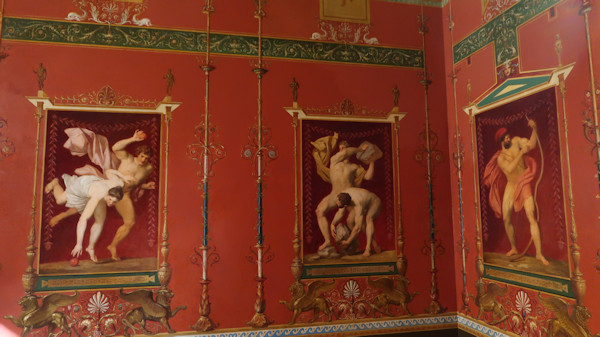
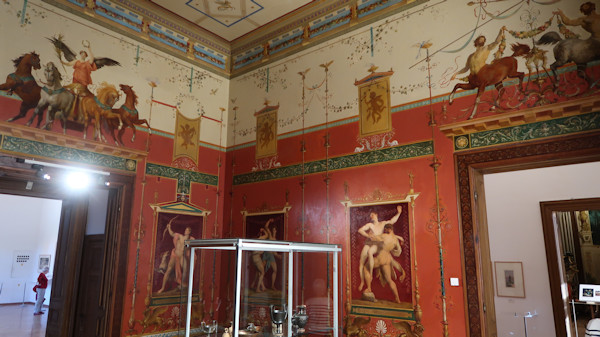
Because of Sisi's predilection for Greek mythology, the walls of the gym room were built in the style of the Pompeian models with depictions of ancient gladiator fights. The original furnishings consisted of a gymnastic apparatus, a balance beam and two sets of rings. The emperor's apartment included a wardrobe, study, bedroom and toiletroom. and the Cabinet Office and was much simpler than the Empress's suite. Remarkable is the spartan brass bed in the bedroom. The second floor was for the Service personnel reserved. It is normally not accessible to visitors today.
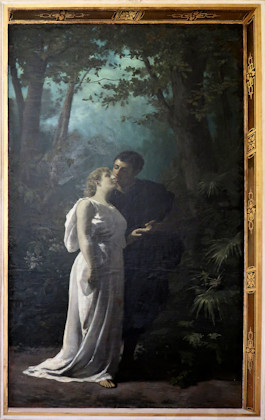
Empress Elisabeth on her arrival at the Hermes Villa on 16 May 1887
Still naht sich der Abend wieder,
Länger werden schon die Schatten:
Diesen Tag auch zu bestatten,
Lässt die dunkle Nacht sich nieder.
Dunkler Wald - aus grünen Zweigen
Scheinen Monde aufzusteigen,
Um mit ihrem Licht, den bleichen,
Durch dies Labyrinth zu zeigen.
Doch nun öffnen sich die Bäume
Halbkreisartig rings im Bogen;
Und mit Mondlicht überzogen
Strahlt Titanias Schloss der Träume.
Silently the evening approaches again,
The shadows are already getting longer:
To bury this day too,
The dark night will settle down.
Dark forest - from green branches
moons seem to ascend,
To lead with their bleach light,
Through this labyrinth.
But now the trees open
Semicircular rings in an arc;
And coated with moonlight
Shines Titania's Castle of Dreams.
The emperor's rooms were located in the north wing, those of the empress in the south wing, from where she could reach her riding school, lit from a glass dome, via a wrought-iron covered corridor.
The bedroom of the empress. The huge state bed dates back to the time of Maria Theresa. The mural paintings after motifs from Shakespeare's "Midsummer Night's Dream" were executed according to designs by Hans Makart. The performing artists included Georg and Gustav Klimt.
Elisabeth's stays in the Hermes Villa
| 1891 | 2. Mai until 19. Mai, 25. Mai until 30. Juni |
| 1892 | 3. Mai until 15. Juni |
| 1893 | 1. Mai until 30. Juni |
| 1894 | 23. April until 23. Juni |
| 1895 | 1. Mai until 30. Juni |
| 1896 | 12. Mai until 1. Juli with the exception of some days spent in Hungary, 24. August until ca. 24. September |
| 1897 | 1. Mai until ca. 7. Mai |
| 1898 | last common stay of the imperial couple in the Hermesvilla. Departure to Bad Ischl on 2 July. |
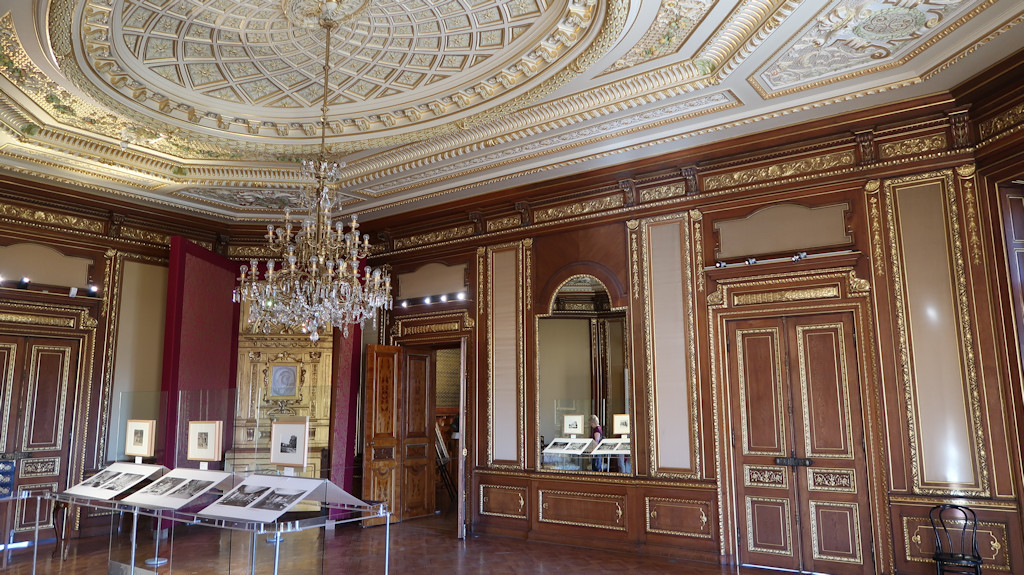
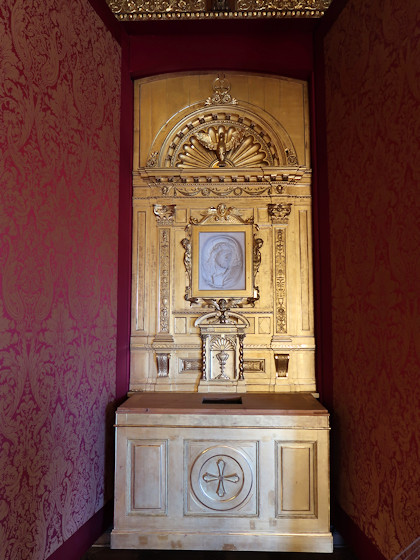
The Tilgnersaal or the "Kirchensaal" with a magnificent ceiling and the house altar in the background.
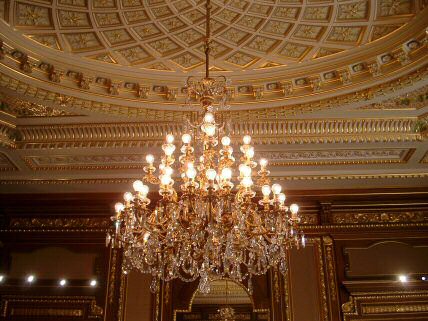
The ceiling looks very impressive when the lights are on. Already in Sisi's times there was an electric lighting here.

This painting by Sisi once stood in the Tilgner Room. Now the portrait of Empress Elisabeth is hanging together with the one of Franz Joseph on the wall in an anteroom used as an exhibition. Both paintings are by Hermann Nigg from 1882.
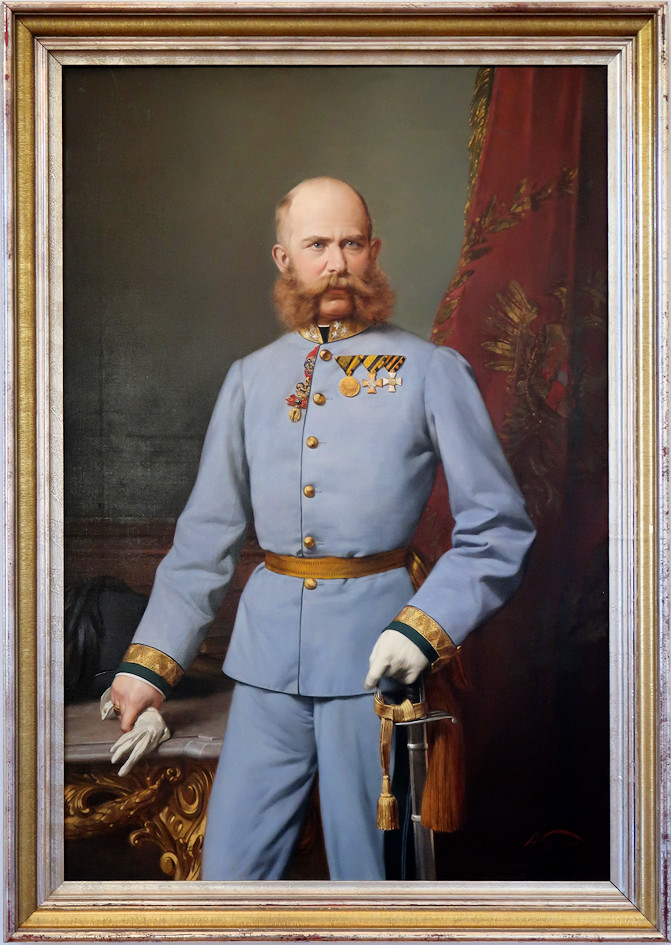

When you click on it, the pictures with frame will be 25 cm high..
The painting of Empress Elisabeth ( Hermann Nigg, c. 1882) and for comparison a b/w photo (detail) of her.

Links to other Sisi pictures from the Sisi Museum in the Hofburg, the Imperial Furniture Collection, the heir to the throne Franz Ferdinand Museum in Artstetten, from Sisi in Madeira and Corfu and their memorials such as in Geneva and her last resting place in the Capuchin crypt.
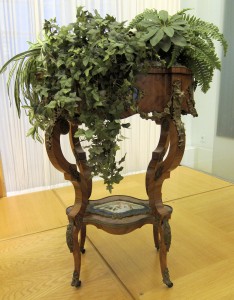
This flower table belongs to the few preserved original furniture. It originally stood in the salon. It is made of rosewood, has gilded bronze fittings as well as porcelain and enamel inlays. However, it is not in the Hermes Villa but in the Imperial Furniture Collection (Hofmobiliendepot) in Vienna.
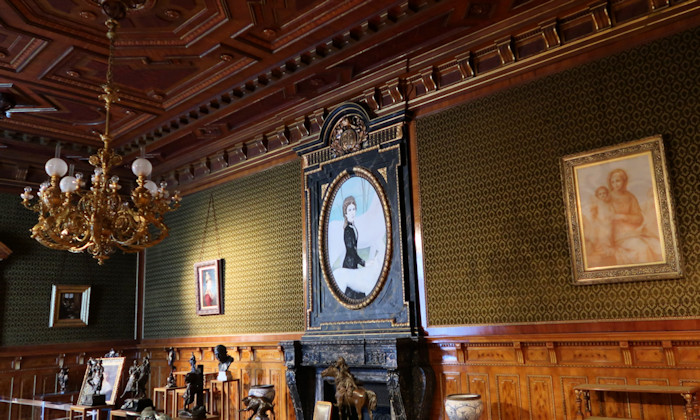
The study of Franz Josef with an unsatisfactory copy of a Sisi picture. In 2006 it was decided to replace the Sisi painting with a work by Katrin Plavcak.
After Sisi's death in 1898 her youngest daughter, Archduchess Marie Valerie, inherited the castle. Unlike her mother, she liked to stay here. She had the rooms furnished according to her taste, but they were restored to their original condition as far as possible during the last restoration.
The original interior is only partially preserved. Already During the Empress's time, paintings and pieces of furniture were frequently exchanged. In 1898, for example, numerous objects from her Achilleion castle in Corfu were brought here. Some of them were later used by the Archduchess Marie Valerie in her main residence Wallsee Castle. Archduchess Gisela also took some souvenirs with her to Munich. During a burglary in January 1919 numerous historical treasures were stolen. As a result, more than 700 pieces of furniture, paintings and decorative objects were seized from the Hofmobilien depot. The remaining silverware was taken to the Court Silver Collection. There were also major losses of works of art and furnishings in 1945, when they were moved to Lower Austria but could no longer be found after the end of the war. After 1971, efforts were made to reunite the old furnishings in the Hermes villa as far as possible using the inventory lists still available.

The park area belonging to the castle has an area of 36 ha. It merges seamlessly into the woods of the 2400 ha Lainzer Tiergarten.
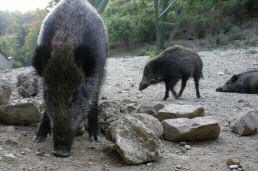
Wild boars in the Lainzer Tiergarten

